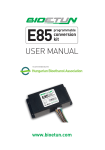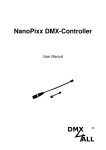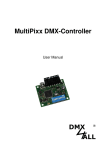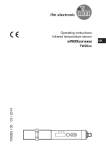Download SERVICE MANUAL - E85 tuning.hu
Transcript
E85 programmable conversion kit SERVICE MANUAL recommended by the Hungarian Bioethanol Association www.bioetun.com 1. THEORETICAL DIAGRAM computer E85 mode switch BioETUN E85 CONVERSION KIT communication wire engine management system ground NTC temperature sensor injectors engine heater pipe Original engine temperature sensor MINIMUM TOOL REQUIREMENTS FOR INSTALLATION • • • • • • • • • digital multimeter (for ohm and voltage measurements) LED break detector (for injector control) soldering iron insulation tape, shrink tube pliers crimp tool for the injector connections tools for opening the car’s dashboard engine housing PC compatible computer, Windows XP operating system, serial port if no serial port is available, usb-rs232 converter INSTALLATION PROCEDURE Step 1: The measurements: Measuring injector resistance The BioETUN 1-4 electronic system is used for the conversion of central- or single cylinder injection automobiles to use E85 fuel. The resistance of the injectors must be measured in all cases, using a simple multimeter. For central injection engines, the system can only be used for controlling 2. injectors above 3 ohms, while for central injection engines, only injectors above 10 ohms can accommodate the system. (Details for the conversion of the first-generation Suzuki Swift central injection model are described in a separate document, available at e85tuning.hu, under the Downloads menu) Determining the injector control signal. Two cables are attached to the injector, through the connectors. Generally, one of them will be +12V, while the other is the negative control signal. BioETUN 1-4 processes and forwards the negative signal, making it important to determine which is the control cable before conversion. A LED break detector, for example, is an appropriate tool for this. (Warning! A detector with an incandescent light bulb should not be used, because the factory electronics can interpret the incandescent bulb as a short circuit, leading to the possibility of a malfunction.) Measuring thermostat voltage The BioETUN 1-4 electronic system can operate with the included NTC heat sensor, in which case further measurements are unnecessary. However, connecting to the car’s factory standard 5V heat sensor is also possible. For the first option, the orange cable should be used, while for the second, the white/orange cable; the electronics should be programmed accordingly via the BioETUN Tuner software. If you wish to perform temperature measurements connected to the factory-standard thermostat, then you will need to find the thermostat wire where 0-5V voltage is present, between cold and hot operation. If there are several thermostats, or one combined thermostat, you will need to find the 5V system in all cases. Step 2: Connecting the electronic system, wiring The BioETUN 1-4 system is capable of independently controlling a maximum of 1-4 cylinders. The device is agnostic to the exact sequence in which the cylinders are connected, but it performs measurements on Channel 1 (black/green - green wire;) hence, that channel needs to be connected in all cases. The wires connecting to the factory standard electronics are always dual colored (for example, black/ yellow,) while the wires connecting to the injectors are single colored (for example, yellow.) The connectors included with the electronic system are composed of plastic housing, rubber gaskets, and connecting pins. It is best to use a crimp tool to attach the pins to the cables, then connect them according to the control pin schematics. Do not forget the rubber gaskets, as they serve to guarantee long-term, oxidation-free operation for the connectors. Power supply for the electronic system is via +12V ignition switch only. Thorough grounding and an appropriate, continuous power supply is a must, even when jump-starting. We suggest that you download the service documents before attempting to connect the electronic system: they are available at e85tuning.hu, under the Downloads menu. (username: e85, password: tuning) While the device is dust- and moisture resistant, we suggest installing it inside the cabin, for instance under the dashboard. Should this not be practicable, it should be installed inside the engine compartment, protected from water, and fixed in place with cable combiners. The device is heatresistant up to 85 degrees Celsius, but must not be installed near sources of radiating heat, such as the turbo or exhaust knee. 2. Optionally, the BioETUN 1-4 electronics warning light can also be installed. The warning light may be a LED or an incandescent bulb of no more than 5 A amperage. The warning light’s operation is detailed in the program description. Switching the purple wire of the mode switcher to ground, the programmed E85 mode will activate. The switch will light up when switched on, so we suggest connecting an ignition-switched +12V next to the switch. The device has a default program, meaning that the car should start with the installed electronics system without need for any further programming. CONNECTING THE SWITCH The switch included in the package is capable of signaling E85 mode. When active, it lights up green. To connect it, you will need ignition-switched +12V, ground, and the connecting wire for the BioETUN 1-4 electronics system (purple wire.) It is a good idea to ensure adequate power supply before installation, possibly via connecting a separate cable off the red (+12V) or the black (ground) wires of the BioETUN electronics system. The switch should be connected as shown on the following diagram: ignition +12V to switch ground CONNECTING THE HEAT SENSOR The NTC heat sensor included with the package is used to monitor the system’s temperature. Using the basic configuration, the cable set is meant for this sensor. The orange cable should be connected to one of the wires, while the ground should be connected to the other. The wire colors are irrelevant, you can solder to any of the prongs; proper grounding is, however, very important. The heat sensor should ideally be affixed to the heating tube with cable ties. It is important to ensure that the sensor not be cooled by air movement during driving. To this end, wrapping it in a thermally resistant and insulating material may be worthwhile. 3. Connecting to the factory standard thermostat is also possible. To do this, connect to the shorter white/orange cable, instead of the orange one. Almost all cars have two or more heat sensors; some types integrate the two into a single thermostat. Make sure that you connect to the 5V factory sensor. Voltage should be above 4V cold, and around 0V hot. The appropriate sensor should be set in the BioETUN TUNER program, with the cold start parameters optimized for the type of sensor in question. CONNECTING THE COMMUNICATIONS PORT BioETUN devices should almost always be optimized for the car in question. After installation, the BioETUN TUNER program can be used to monitor precise operation. The newest version of the BioETUN TUNER program can be downloaded from www.bioetun.com by clicking on the Download menu. The DSUB9-es 9-pin connector included in the package can be used to connect to the electronic system. Be careful when attaching the connector; most communications malfunctions are caused by not connecting all of the prongs correctly. The prong numbers are visible on the connector; this should be of great help when attaching the connector. The correct attachment of connector can be seen on the following diagram: ICRIMPING THE INJECTOR CONNECTORS 2 - white/yellow 3 - white/brown 5 -black/white or white/blue soldered side view 4. A crimp tool will be necessary for properly attaching the injector connectors included in the package. Ensure that the rubber gaskets are attached securely to the connecting pins. Always crimp them together with the connectors. If the gaskets are misaligned on the wires or are insufficiently attached, they will fail to operate adequately, and water or vapor can enter the injector connectors. This can eventually lead to oxidation. A common issue is not squeezing the crimp tool hard enough, allowing the cable to slip off the prong. Carefully push the prongs and the prepared connectors together, making sure they click into place. Double-check correct prong distribution, because removing them later on will be difficult, will require a specialized tool, and removal can potentially damage the connector or the prongs. The new gaskets may require using slightly more force to click the components together. When properly connected, there should be a clearly audible click. A common issue—especially for Nippon Denso connectors—involves the opening of the female connectors being slightly wider than the prong of the respective male connector. Make sure to check for this, as it can lead to faulty contacts. If necessary, a tiny screwdriver can be used to modify the tightness of the female connector. Always use a furry fabric cable tie to affix the cables together. The connected connectors can be tied to the original cables or the combiner with cable ties. If installing them inside the engine housing, ensure that nothing is pressing on the connections, and none of the contact are vibrating. When preparing the injector connectors, you will need jumper cables for every cylinder, which will be used to transmit the power needed for operating the injectors. These jumper cables should be roughly 150-200 mms in length, and should have a male connector on one end, and a female on the other. Ensure accurate prong distribution! The jumper cables should be connected as shown on the following diagram: Jumper cable (+12V) Male connector towards an engine controller Female connector onto injector 5. CONNECTING A SUZUKI SWIFT TBI Control for a Swift Throttle Body Injection (central injection) can be achieved by connecting the first two channels (black/ green+black/blue or green/blue) in parallel. The components should be connected as shown on the following diagram: Injector control: from a frontal view, the yellow/black cable for the grey connector on the left side of the central injector. The other yellow cable is the + power for the injector. Warning: do not attempt to use this as the power source for the BioETUN system! ground: from the firewall, next to the ignition coil power: ignition switch +12 V from the ignition coil NTC heat sensor positioning: cable-tied to the water pipe behind the engine, protected against cooling. After cutting the yellow/black cable, the singlecolor green and blue cables twisted together towards the injector. The black/green and black/ blue cables, twisted together, should be wired towards the cable set, that is, the factory standard engine control. E85 +12V blue programmable conversion kit grey black/yellow yellow wire connection black/grey black purple AD1 orange +12V Injector black/blue MADE IN HUNGARY Body +12V Injector black/green Configuration switch (included in package) NTC heat sensorr (included in package) +12V Injector Factory engine thermostat (optional) NOTE: Only one of the two can be selected Injector green + DSUB9 +12V ignition switch (15) 5 3 2 Communications connector For a 4-injector vehicle Connection diagram white/yellow or white white/brown or red/white - Mode display light (LED) black/white or white/blue brown red factory engine control további információ: www.bioetun.hu

















